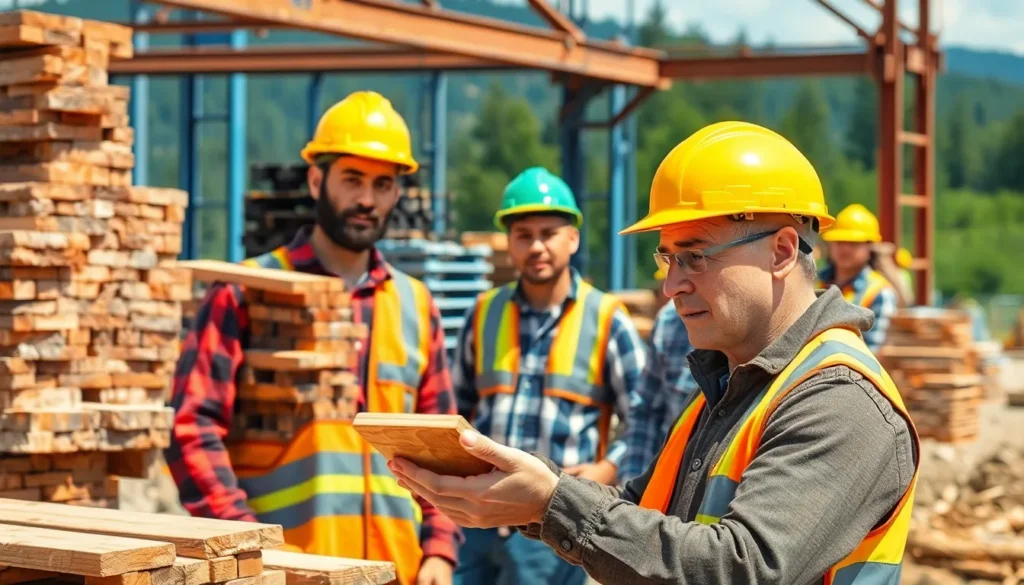Table of Contents
ToggleBuilding a house is like crafting a masterpiece, and the materials you choose are the brushstrokes that bring it to life. Whether it’s the sturdy embrace of timber or the sleek sophistication of steel, every material tells a story. But let’s face it—navigating the world of house building materials can feel like trying to find a needle in a haystack, while blindfolded.
Overview of House Building Materials
House building materials form the foundation of any construction project, significantly impacting durability, aesthetics, and energy efficiency. Various categories exist, ranging from traditional substances like wood and brick to modern composites and engineered products. Each material plays a unique role in the overall structure.
Wood, commonly used for framing and flooring, offers strength coupled with a pleasing appearance. Its thermal insulation properties enhance energy efficiency in homes. Options like treated lumber and engineered wood products provide added durability and sustainability, meeting modern building requirements.
Brick stands out for its fire resistance and longevity. This material contributes to excellent thermal mass, helping to regulate indoor temperatures. Bricks come in various textures and colors, allowing for versatile design choices.
Concrete delivers exceptional structural integrity. This material supports heavy loads and withstands adverse weather conditions. It can be molded into various forms, making it suitable for foundations, walls, and flooring.
Steel ranks high for its strength-to-weight ratio. This material facilitates open floor plans and large spans, often used in commercial and residential structures. Steel frames may also be combined with other materials for enhanced functionality.
Glass is becoming increasingly popular in contemporary designs. Large windows and glass doors invite natural light and create a sense of spaciousness. Energy-efficient glass options help minimize heat transfer, improving energy performance.
Choosing the right materials necessitates careful consideration of local climate and building regulations. Understanding the benefits of each option empowers builders and homeowners to make informed decisions, ensuring that their homes not only meet aesthetic desires but also withstand the test of time.
Types of House Building Materials

House building materials can be classified into natural and synthetic categories, each offering unique benefits.
Natural Materials
Natural materials include wood, stone, and clay. Wood provides strength, aesthetic warmth, and superior thermal insulation. Stone offers durability and a timeless appeal, proving resistant to weather and aging. Clay, often formed into bricks, enhances fire resistance and thermal mass. These materials typically come from sustainable sources, contributing to eco-friendliness. Homeowners often value the charm and character that natural materials impart, allowing for creativity in design while fostering a connection to the environment.
Synthetic Materials
Synthetic materials comprise concrete, steel, and engineered wood products. Concrete is renowned for its structural integrity, allowing for versatile design and durability. Steel exhibits a remarkable strength-to-weight ratio, enabling expansive open floor plans in modern architecture. Engineered wood products combine the advantages of wood while reducing waste, providing consistent quality and stability. Homebuilders favor these materials for their cost-effectiveness and low maintenance. Alongside functionality, these synthetic options often align with contemporary design trends, appealing to modern homeowners.
Advantages and Disadvantages of Materials
Selecting appropriate building materials possesses distinct advantages and disadvantages. Understanding these factors influences construction decisions and enhances project outcomes.
Cost Considerations
Cost plays a critical role when selecting building materials. Traditional materials like wood and brick often require significant upfront investment. Though durable, materials such as steel may present higher costs due to fabrication and transportation. Conversely, engineered materials offer alternatives that can lower expenses, promoting budget-friendly projects. Long-term maintenance costs also matter; some materials require more upkeep than others, impacting overall budgets.
Environmental Impact
The environmental impact of materials has gained importance in recent years. Natural materials, like wood and stone, often present lower carbon footprints and enhance sustainability. These materials also support environmentally friendly building practices. Synthetic materials, while often more affordable, can contribute to higher emissions during production and disposal. Choosing eco-conscious options encourages sustainable development, aligning construction practices with modern environmental standards.
Innovations in House Building Materials
Innovations continue to reshape the landscape of house building materials, enhancing sustainability and functionality.
Sustainable Options
Sustainable building materials focus on eco-friendliness and efficiency. Bamboo stands out due to its rapid growth and strength. Reclaimed wood offers aesthetic appeal while reducing waste. Products made from recycled materials, such as insulation and roofing, also minimize environmental impact. Straw bales provide excellent insulation and can significantly lower energy costs. Moreover, natural fibers and plant-based composites contribute to lower carbon footprints. Each of these options supports sustainable practices, making them increasingly popular among eco-conscious builders and homeowners.
Smart Materials
Smart materials enhance the functionality of traditional building materials. These materials adapt to environmental changes and improve energy efficiency. Thermochromic materials change color based on temperature, providing thermal regulation. Photovoltaic glass integrates solar energy generation into windows. Self-healing concrete repairs cracks automatically, extending the lifespan of structures. Additionally, lightweight materials include sensors that monitor structural integrity. Each innovation adds value and leads to smarter, more responsive homes. Contemporary architecture increasingly incorporates these technologies, reflecting a commitment to modern living.
Selecting the right house building materials is crucial for creating a home that stands the test of time. Each material brings unique qualities that influence durability, aesthetics, and energy efficiency. As builders and homeowners navigate their choices, understanding the benefits and drawbacks of both natural and synthetic options can lead to informed decisions.
Innovations in sustainable materials are paving the way for smarter homes that prioritize eco-friendliness and functionality. Embracing these advancements not only enhances the living experience but also contributes to a more sustainable future. By considering local climate and regulations, individuals can ensure their homes are not just beautiful but also resilient and efficient.




